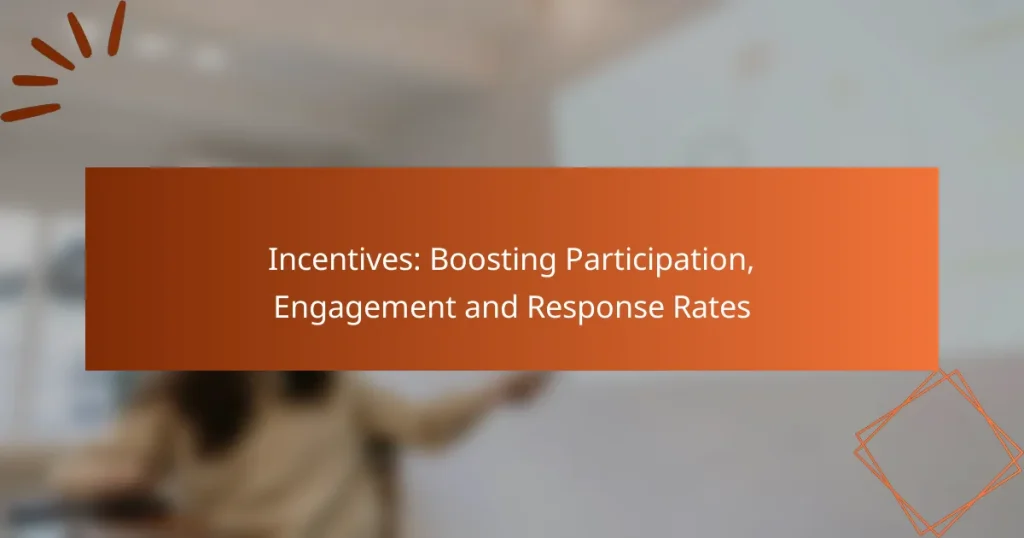Incentives play a crucial role in enhancing participation and engagement in marketing campaigns by motivating potential customers to interact with a brand. By providing rewards, discounts, or exclusive access, businesses can effectively attract more participants and improve response rates. Additionally, incorporating gamification strategies can further increase engagement by making activities more enjoyable and appealing to users’ competitive instincts.
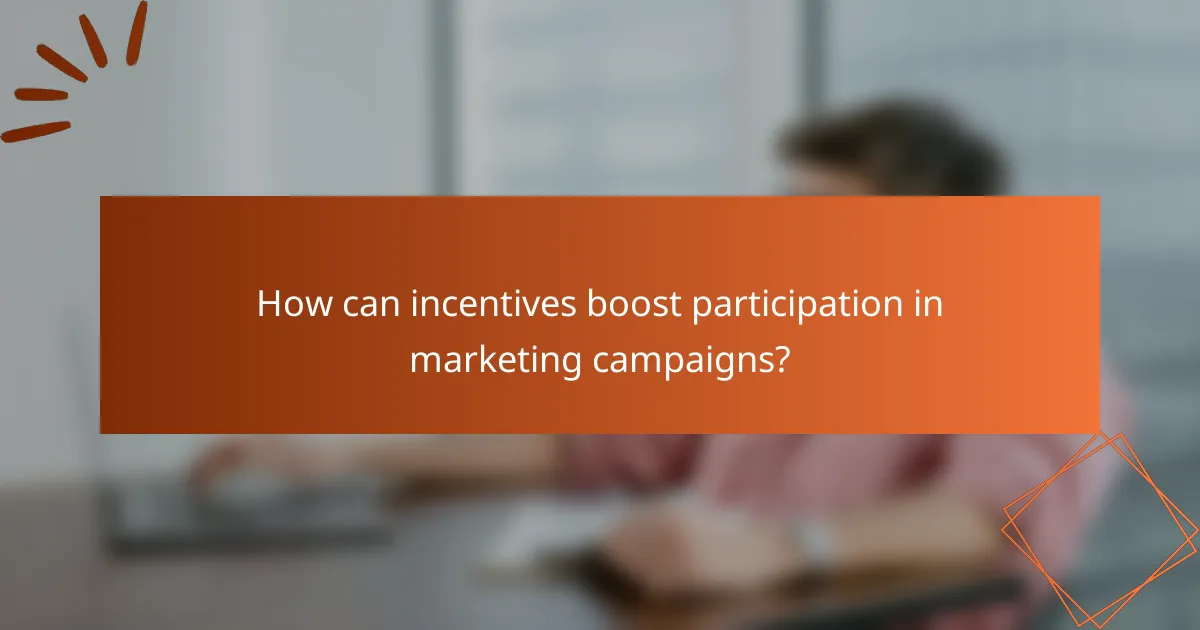
How can incentives boost participation in marketing campaigns?
Incentives can significantly enhance participation in marketing campaigns by motivating potential customers to engage with a brand. By offering rewards, discounts, or exclusive access, businesses can attract more participants and increase overall response rates.
Increased engagement through rewards
Offering rewards is a powerful way to boost engagement in marketing campaigns. When customers know they will receive something of value, such as discounts or freebies, they are more likely to participate actively. For instance, a survey might offer a chance to win a gift card, encouraging higher response rates.
To maximize effectiveness, consider using tiered rewards, where participants can earn greater incentives based on their level of engagement. This approach not only motivates initial participation but also encourages ongoing interaction with the brand.
Enhanced customer loyalty programs
Incentives play a crucial role in enhancing customer loyalty programs by rewarding repeat business. Programs that offer points for purchases, referrals, or social media shares can create a sense of belonging and appreciation among customers. For example, a coffee shop might provide a free drink after a certain number of purchases, fostering loyalty.
When designing loyalty programs, ensure that the rewards are attainable and relevant to your target audience. Regularly updating the incentives can keep customers engaged and interested, preventing stagnation in participation rates. Consider integrating mobile apps for easy tracking and redemption of rewards, which can further streamline the customer experience.
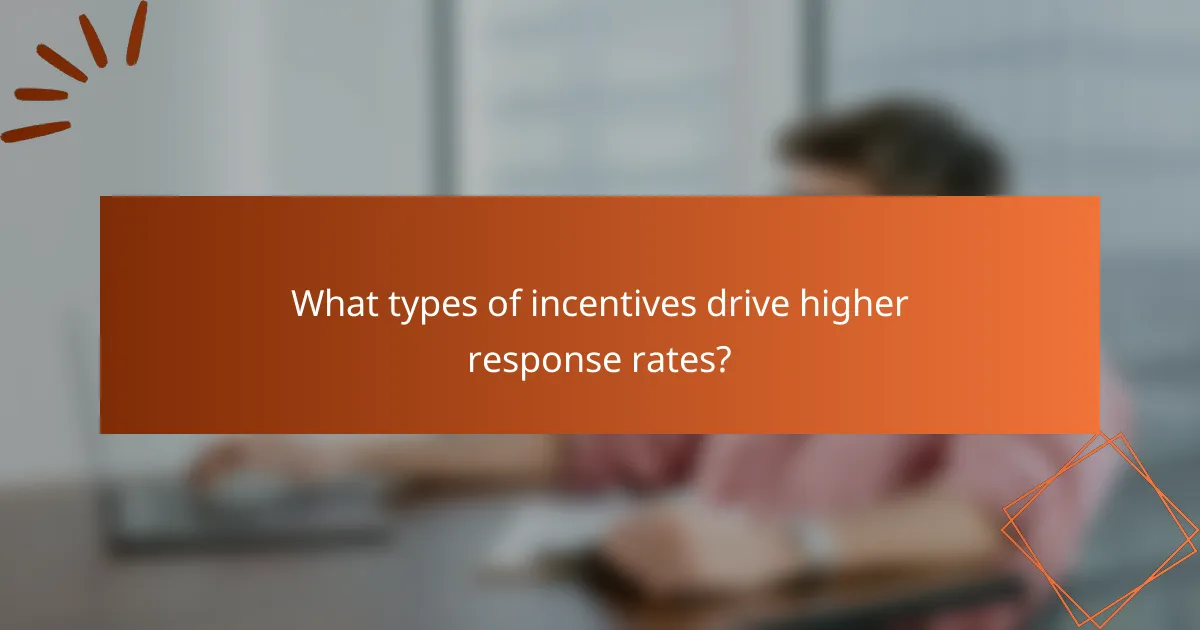
What types of incentives drive higher response rates?
Incentives that effectively boost response rates typically include monetary rewards and exclusive access to products. These incentives motivate participants by offering tangible benefits that enhance their engagement and willingness to respond.
Monetary rewards
Monetary rewards are direct financial incentives that can significantly increase response rates. These can range from small cash payments to gift cards or discounts, appealing to participants’ desire for immediate gratification.
When implementing monetary incentives, consider the target audience’s preferences and the perceived value of the reward. For example, offering a $10 gift card may be more effective than a $5 cash incentive, depending on the context and demographics.
However, be cautious of potential pitfalls. Over-reliance on monetary rewards can lead to participants only engaging for the financial benefit, rather than genuine interest in the subject matter.
Exclusive access to products
Exclusive access to products serves as a compelling incentive by providing participants with something they cannot obtain elsewhere. This could include early access to new products, special editions, or members-only events, which can create a sense of privilege and urgency.
To maximize the effectiveness of this incentive, ensure that the products or experiences offered are relevant and desirable to your audience. For instance, tech enthusiasts might respond well to early access to a new gadget, while fashion consumers may appreciate exclusive previews of a clothing line.
It’s essential to communicate the exclusivity clearly to enhance its appeal. Highlighting limited availability or unique features can further motivate participants to engage and respond promptly.
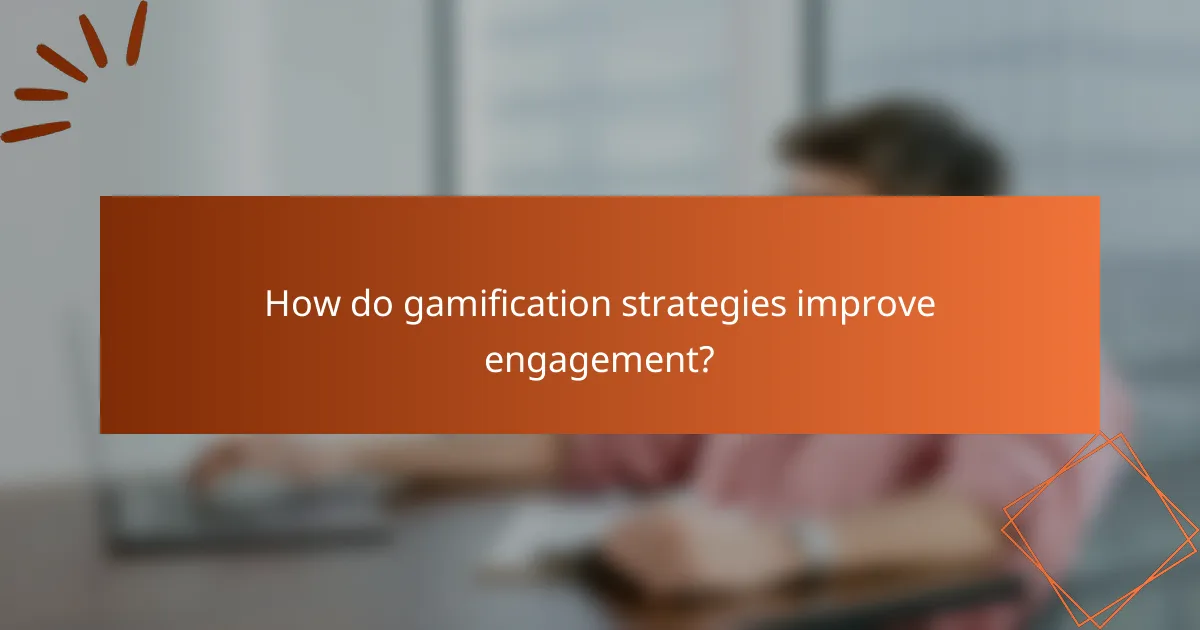
How do gamification strategies improve engagement?
Gamification strategies enhance engagement by incorporating game-like elements into non-game contexts, making activities more enjoyable and motivating. These strategies can significantly boost participation and response rates by appealing to users’ competitive instincts and desire for achievement.
Point systems for user actions
Point systems reward users for completing specific actions, such as participating in surveys, sharing content, or achieving milestones. By assigning points for these activities, users feel a sense of accomplishment and are encouraged to engage more frequently. For example, a platform might award 10 points for each completed survey, creating a tangible incentive for users to participate.
When implementing a point system, it’s crucial to ensure that the points are meaningful and lead to desirable rewards. Consider offering tiered rewards, where users can exchange points for discounts, exclusive content, or recognition. This approach can further motivate users to accumulate points and engage with the platform.
Leaderboards to encourage competition
Leaderboards foster a sense of competition among users by displaying rankings based on points or achievements. This visibility can drive engagement as users strive to improve their standings and gain recognition. For instance, a monthly leaderboard could showcase the top ten participants, encouraging others to increase their activity to reach these ranks.
To maximize the effectiveness of leaderboards, consider implementing features like weekly resets or different categories for various activities. This keeps the competition fresh and allows more users to have a chance at recognition, preventing discouragement among those who may not consistently rank at the top.

What are the best practices for implementing incentives?
Effective implementation of incentives involves clear communication, targeted audience segmentation, and understanding the motivations of participants. By following best practices, organizations can enhance participation, engagement, and response rates significantly.
Clear communication of benefits
Clearly outlining the benefits of participating in an incentive program is crucial for attracting interest. Participants should understand what they stand to gain, whether it’s monetary rewards, discounts, or exclusive access to products and services.
Use straightforward language and highlight the most appealing aspects of the incentives. For example, if offering a cash reward, specify the amount and any conditions attached to it. This transparency builds trust and encourages participation.
Targeted audience segmentation
Segmenting your audience allows for tailored incentive strategies that resonate with specific groups. By analyzing demographics, interests, and behaviors, you can design incentives that are more likely to engage each segment effectively.
For instance, younger audiences may respond better to digital rewards, while older demographics might prefer traditional incentives like gift cards. Consider using surveys or data analytics to refine your audience segments and their preferences.
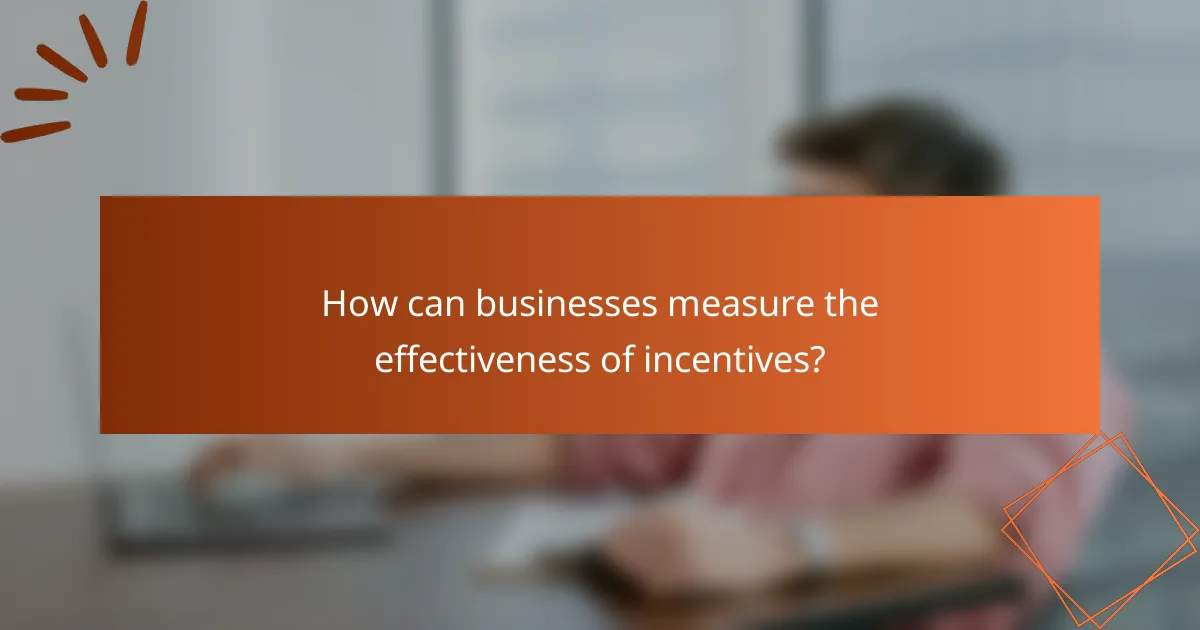
How can businesses measure the effectiveness of incentives?
Businesses can measure the effectiveness of incentives by analyzing participation rates and customer feedback. These metrics provide insights into how well the incentives are driving engagement and whether they meet customer expectations.
Tracking participation rates
Tracking participation rates involves monitoring the number of individuals who engage with the incentive programs. This can be done through registration logs, response rates to surveys, or participation in promotional events. A good target is to aim for participation rates in the range of 20-50% depending on the incentive type.
To effectively track these rates, businesses should establish clear benchmarks before launching an incentive. Comparing participation rates against these benchmarks can help identify which incentives are successful and which may need adjustments. Regularly reviewing these metrics allows for timely modifications to enhance engagement.
Analyzing customer feedback
Analyzing customer feedback is crucial for understanding the perceived value of incentives. Businesses can gather feedback through surveys, focus groups, or online reviews. This qualitative data helps identify what aspects of the incentives are appealing and what may be lacking.
To maximize the effectiveness of feedback analysis, companies should ask specific questions related to the incentives, such as clarity, attractiveness, and relevance. Utilizing a mix of quantitative ratings and qualitative comments can provide a comprehensive view of customer sentiment. Regularly reviewing this feedback allows businesses to refine their incentive strategies and better align them with customer preferences.

What role do social media platforms play in incentive programs?
Social media platforms are crucial for incentive programs as they enhance visibility and engagement. By leveraging these platforms, businesses can reach a broader audience and encourage participation through various interactive elements.
Increased visibility through shares
When users share content related to incentive programs on social media, it significantly boosts visibility. Each share can expose the program to new potential participants, expanding the reach beyond the initial audience.
To maximize this effect, create shareable content that resonates with users. This could include engaging visuals, compelling calls to action, or enticing rewards that encourage users to spread the word.
Engagement through interactive content
Interactive content, such as polls, quizzes, or contests, can enhance user engagement in incentive programs. These formats not only attract attention but also encourage users to participate actively, increasing their investment in the program.
Consider incorporating elements like gamification or tiered rewards that incentivize users to engage more deeply. For example, offering bonus entries for sharing the program or completing specific tasks can drive higher participation rates.
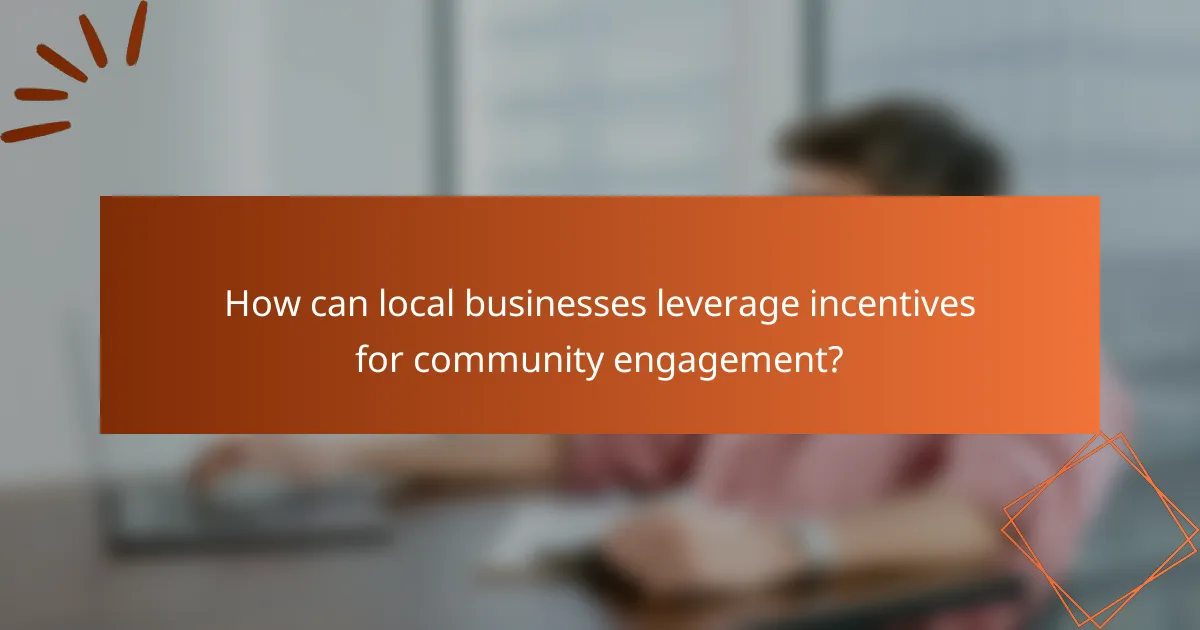
How can local businesses leverage incentives for community engagement?
Local businesses can effectively leverage incentives to enhance community engagement by offering rewards that motivate participation. These incentives can range from discounts and freebies to exclusive events, fostering a sense of belonging and encouraging customers to interact with the business.
Partnerships with local influencers
Collaborating with local influencers can significantly amplify the reach of incentive programs. Influencers already have established trust and rapport with their audiences, making them ideal partners for promoting community engagement initiatives.
When selecting influencers, consider their alignment with your brand values and their audience demographics. For instance, a local fitness influencer could promote a health-focused incentive program, attracting health-conscious customers to your business.
To maximize effectiveness, create clear guidelines for influencers on how to present the incentives. This could include specific messaging, hashtags, or even co-hosting events. Regularly assess the partnership’s impact on engagement to refine future collaborations.
